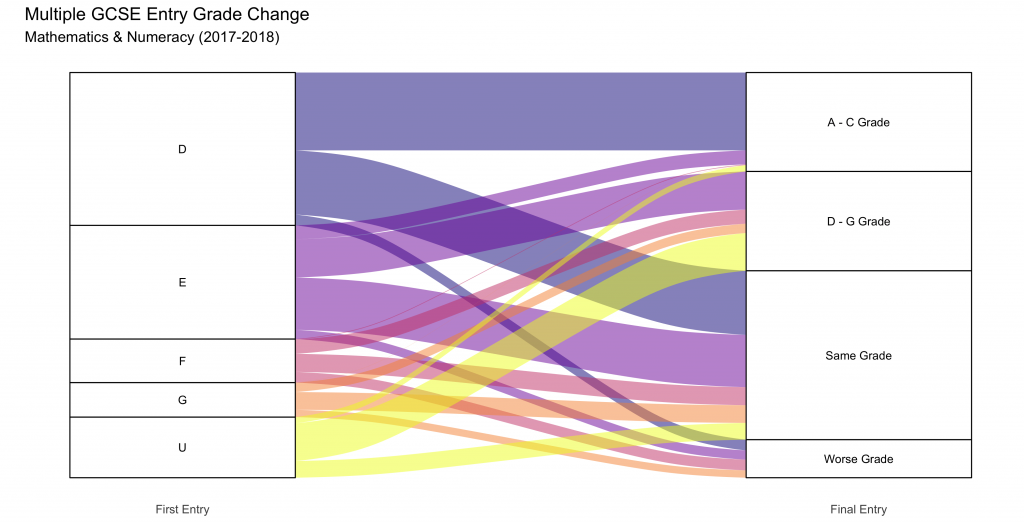Mae'r cynnwys hwn ar gael yn Saesneg yn unig.
A previous blog introduced the context and patterns of early entries to GCSEs in Wales. This blog builds on this to examine the practice of multiple entry and the effect that this has on grades.
Using national data of all pupils in Wales who completed Year 11 between 2006 and 2018, we distinguished between pupils who were entered for a subject once and on-time, once and early, and those who were entered multiple times. Of the subjects which saw the highest proportion of early entry, Mathematics GCSE and Mathematics – Numeracy GCSE were the subjects which were most commonly sat multiple times. Most notably, but not exclusively, in the last few years: rising to over 50% of all pupils who completed Year 11 in 2017 being entered more than once. This coincided with the introduction of new WJEC qualifications. We use this data here to illustrate the patterns and relationships found in our more detailed analysis.
Investigation of the different grades achieved by those who had a single early entry and the first attempt of those who had multiple entry, found two differing patterns. The proportion of those achieving a grade C or above in the single early entry group was higher (at 67%) than the proportion achieving a grade C or above for the first of multiple attempts (31%). This suggests distinction between the purpose of early entry for the two groups: single early entry for those being entered early in order to get that particular exam out of the way, by ‘banking’ the grade, and multiple entry for those who may need the opportunity to re-enter the GCSE, in order to maximise the potential for a highest possible grade.
The extent to which multiple entry improves pupils’ final GCSE grade and whether any improvement is worth the potential impact this has on achievement and progression has been questioned. Whilst arguments around the use of multiple entry may be more nuanced in other subjects, there is a need for pupils to meet the grade C ‘threshold’ (i.e. achieve a grade C or higher) in Mathematics particularly, for progression both to further study and into the wider labour market. We combined the results of Mathematics and Mathematics – Numeracy over the last two years to look at the changes in GCSE grade from first to last (usually second) attempt.

The diagram above shows the change in grade for those that did not meet the C threshold at the first attempt (62% of those that sat multiple times). It shows that, for these students, whilst around a half achieved a better grade only around a quarter moved to a grade C or above. In fact, of those who were entered for multiple entry (including those with higher grades at their first attempt), the proportion that move from below to a C or above is just 15%. The majority of these are those who gain a grade D at their first attempt, with just over half of these pupils meeting the C threshold.
It is worth noting that it does not affect a pupil’s overall grade if their grade goes down over the multiple attempts; pupils keep their best grade regardless. However, the relatively low proportions achieving higher grades and meeting the C threshold does lead to a question mark being placed over whether multiple entry has been used in the most efficient and effective way.
Multiple entry practices within compulsory education are likely to decrease given the recent reforms to school performance reporting to discourage the practice. Rather than eradicate multiple entry, this is likely to shift multiple entry to late, rather than early, entry – a practice which already exists, as individuals try to obtain the important C grade in mathematics. This is something that we can investigate as and when that data becomes available.
———————–
About the WISERD Education Data Lab:
WISERD Education Data Lab undertakes independent analysis of administrative education data, survey data and data linkage, alongside knowledge exchange and public dissemination of findings to inform national debate on some of the most contemporary and pressing educational issues facing Wales.
WISERD Education Data Lab is funded by Welsh Government, Economic and Social Research Council (award: ES/012435/1) and Cardiff University.
The statistics used in this report have been approved for publication by SAIL. This does not imply Welsh Government’s acceptance of the validity of the methods used to obtain these statistics, or of any analysis of the results. Rather, they have been deemed to be non-disclosive (i.e. individual pupils cannot be identified).


